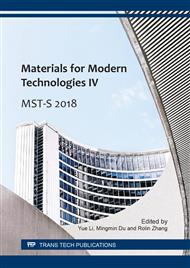[1]
M. Momirlan, T. Veziroglu, The properties of hydrogen as fuel tomorrow in sustainable energy system for a cleaner planet, International Journal of Hydrogen Energy 30 (2005) 795-802.
DOI: 10.1016/j.ijhydene.2004.10.011
Google Scholar
[2]
Wang JW, Wang YF, Zhang JG, Optimization of electrocatalytic properties of NiMoCo foam electrode for water electrolysis by post-treatment processing, Rare Metals 34 (2015) 802-807.
DOI: 10.1007/s12598-015-0592-4
Google Scholar
[3]
K. Zeng, D.K. Zhang, Recent progress in alkaline water electrolysis for hydrogen production and applications, Progress in Energy and Combustion Science 36 (2010) 307-326.
DOI: 10.1016/j.pecs.2009.11.002
Google Scholar
[4]
M.M Jaksic, Electrocatalysis of hydrogen evolution in the light of the brewer-engel theory for bonding in metals and intermetallic phases, Electrochimica Acta29 (1984) 1539-1550.
DOI: 10.1016/0013-4686(84)85007-0
Google Scholar
[5]
P. Salvi, P. Nelli, M. Villa, et al., Hydrogen evolution reaction in PTFE bonded Raney Ni electrodes, International Journal of Hydrogen Energy, 36 (2011) 7816-7821.
DOI: 10.1016/j.ijhydene.2011.01.173
Google Scholar
[6]
Tang C, Pu Z H, Liu Q, AsiriAM, Luo YL, Sun XP, Ni3S2nanosheets array supported on Ni foam: A novel efficient three-dimensional hydrogen-evolving electrocatalyst in both neutral and basicsolutions, International Journal of Hydrogen Energy 40 (2015).
DOI: 10.1016/j.ijhydene.2015.02.038
Google Scholar
[7]
J.H. Zhang, Z.L. Hui, Z.Q. Fang, Preparation and Properties of Nickel Foam, Rare metals, 25 (2001) 230-234.
Google Scholar
[8]
M.M. Jaksic, Advances in electrocatalysis for hydrogen evolution in the light of the Brewer-Engel valance-bond theory, International Journal of Hydrogen Energy 12 (1987) 727-752.
DOI: 10.1016/0360-3199(87)90090-5
Google Scholar
[9]
P. Kedzierzawski, D. Oleszak, M. Janik-Czachor, Hydrogen evolution on hot and cold consolidated Ni-Mo alloys produced by mechanical alloying, Materials Science & Engineering A 300 (2001) 105-112.
DOI: 10.1016/s0921-5093(00)01672-5
Google Scholar
[10]
Q. Han, S. Cui, N.W. Pu, et al., A study on pulse plating amorphous Ni-Mo alloy coating used as HER cathode in alkaline medium, International Journal of Hydrogen Energy35 (2010) 5194-5201.
DOI: 10.1016/j.ijhydene.2010.03.093
Google Scholar
[11]
Y. Zeng, S.W. Yao, H.T. Guo, Electrodeposition of amorphous Ni-Mo alloy, Chinese Journal of Plationg and Finishing 16 (1994) 9-12.
Google Scholar
[12]
L. Huang, S.K. Xu, Properties and Structure of Nanocrystalline Ni-Mo Alloy Electrodeposition, Chinese Journal of Applied Chemistry 16 (1999) 38-41.
Google Scholar
[13]
S.L. Wang, Y. Zhang, Preparation and Electrocatalytic Performance of Ni-Mo/LaNi5 Ni-Mo/LaNi5 Porous Composite Electrode toward Hydrogen Evolution Reaction, Acta Physico-Chimica Sinica 27 (2011) 1417-1423.
DOI: 10.3866/pku.whxb20110510
Google Scholar
[14]
J. Kubisztal, A. Budniok, A. Lasia, Study of the hydrogen evolution reaction on nickel-based composite coatings containing molybdenum powder, International Journal of Hydrogen Energy 32 (2007) 1211-1218.
DOI: 10.1016/j.ijhydene.2006.11.020
Google Scholar
[15]
F.I. Danilov, A.V. Tsurkan, E.A. Vasileua, V.S. Protsenko, Electrocatalytic activity of composite Fe/TiO2 electrodeposits for hydrogen evolution reaction in alkaline solutions, International Journal of Hydrogen Energy 41 (2016) 7363-7372.
DOI: 10.1016/j.ijhydene.2016.02.112
Google Scholar
[16]
B. Losiewicz, A. Budniok, E. Rowinski, E. Lagiewka, A. Lasia, The structure, morphology and electrochemical impedance study of the hydrogen evolution reaction on the modified nickel electrodes, International Journal of Hydrogen Energy 29 (2004).
DOI: 10.1016/s0360-3199(03)00096-x
Google Scholar
[17]
Z. Jia, C.S. Dai, L. Chen, Electrochemical Test Method, first ed., Beijng, (2006).
Google Scholar
[18]
M. Jafariana, O. Azizi, F. Gobal, Kinetics and electrocatalytic behavior of nanocrystalline CoNiFe alloy in hydrogen evolution reaction, International Journal of Hydrogen Energy 32 (2007) 1686-1693.
DOI: 10.1016/j.ijhydene.2006.09.030
Google Scholar
[19]
C. Hitz, A. Lasia, Experimental study and modeling of impedance of the her on porous Ni electrodes, Journal of Electroanalytical Chemistry 500 (2001) 213-222.
DOI: 10.1016/s0022-0728(00)00317-x
Google Scholar


